The Neoclassical Marvels of Syros: Bridging History and...
While some historic buildings teeter on...

A colorful breakfast at the hotel Mediterraneo.
© Nikos Pilos
I first visited Kastellorizo 20 years ago, flying in from Rhodes on a 15-seat Olympic Airlines “puddle-jumper.” The landing at the airstrip on a mountain plateau was one of the most adventurous I’d experienced. A scene of unbelievable beauty unfolded before my eyes, framed by the sea and the mountains of Lycia in Turkey across the way, in the most bizarre game of geography I’d ever seen, as mountains and boundaries became all tangled up in an odd trick of perspective.
I fell in love with Kastellorizo, and now I return every summer. Each time I arrive, I feel that same joy, undiminished and equally peculiar – each time I look down on the walks I’ve taken to the castle and the monasteries on the mountain; each time I enter or leave the port by boat; and each time I go out rambling with no particular destination in mind, exchanging good mornings, good evenings, and buona seratas on the narrow Kordoni, the walkway along the harbor, hoping it will never have to suffer the unfortunate “progress” of megalomaniac expansion and will, instead, be left to survive as it has for ages.
I fell in love with Kastellorizo, which rewarded me in turn by revealing its people to me, the remnants of its history, its cosmopolitan youth, the colonists of its past and those of the present. Like a novel by Borges that weaves multiple plotlines together, each summer, every so often, a new story unfolds.
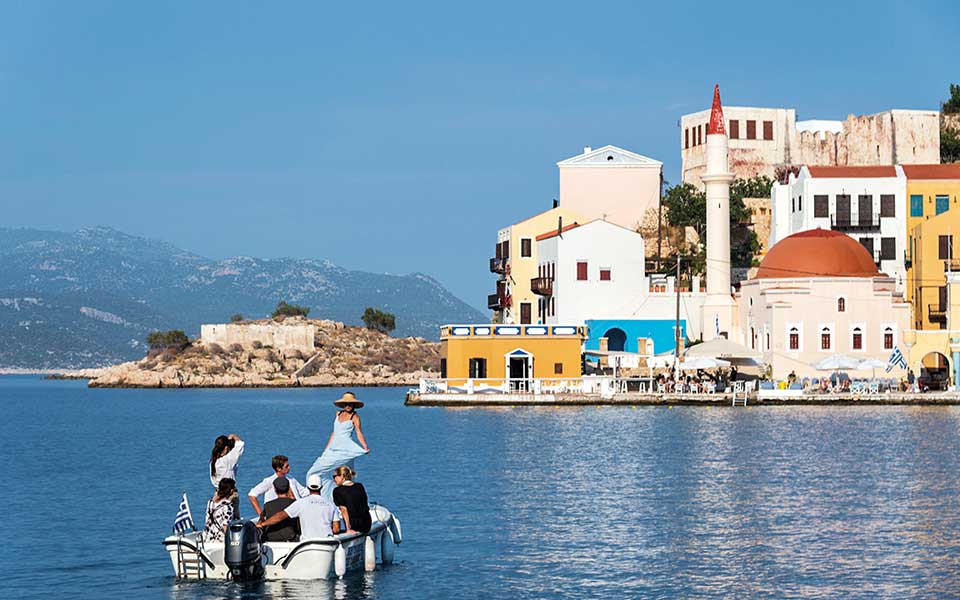
© Nikolas Leventakis
For many years, I experienced the island from “Marie’s Pillows,” the downstairs room at the hotel Mediterraneo at the edge of the harbor. The room seems almost to be floating, with three large arches, which I would pass through all day long, going out to dive into the water (yes, right there at the port), making playlists and listening to them, lying and gazing out at the same beautiful scene, like a painting: the small mosque, the spiral staircase at the top of the Port Police, the neoclassical buildings along the waterfront. I would spend all day waiting for a single moment: that instant when night would enter the body of day, the split second when the electric lamps would come alive all at once.
Little Kastellorizo proved to be rich in pleasures. I remember, in random order: meals out under the plane trees at Ta Platania, in the town’s upper square, where dishes are served on tables covered in flowered tablecloths; invitations to parties at the three houses of Ascania Baldasseroni and her late husband, Michele Spadafora, Prince of Palermo, each with its own outdoor sofa around a Sicilian fountain; and the yearly dinner party on the water at the beautiful home of Katerina Stouraiti-Mezzedimi, Greek consul in Djibouti, and her architect husband Sergio, featuring the spicy chicken doro wat prepared by her Ethiopian cook. Or our evening outings along the Kordoni: Konstantis and Pantelis, sons of Stratos and Amalia, grew up and took over Stratos Café, where they serve amazing cocktails. Ilias, son of Nikitas, also took over the helm of the family taverna of the same name and makes incredible profiteroles. Kyriakos at Billy’s fish taverna, Vangelis at Alexandra’s taverna, Giorgos at Lazarakis and Nikos at Athena fish taverna compete every day to see who can best master the art of cooking fish. And at Radio Café, time always moves slowly.
Kastellorizo is both cosmopolitan and entirely, characteristically Greek – and those two sides come together most at night, in the island’s houses and gardens.
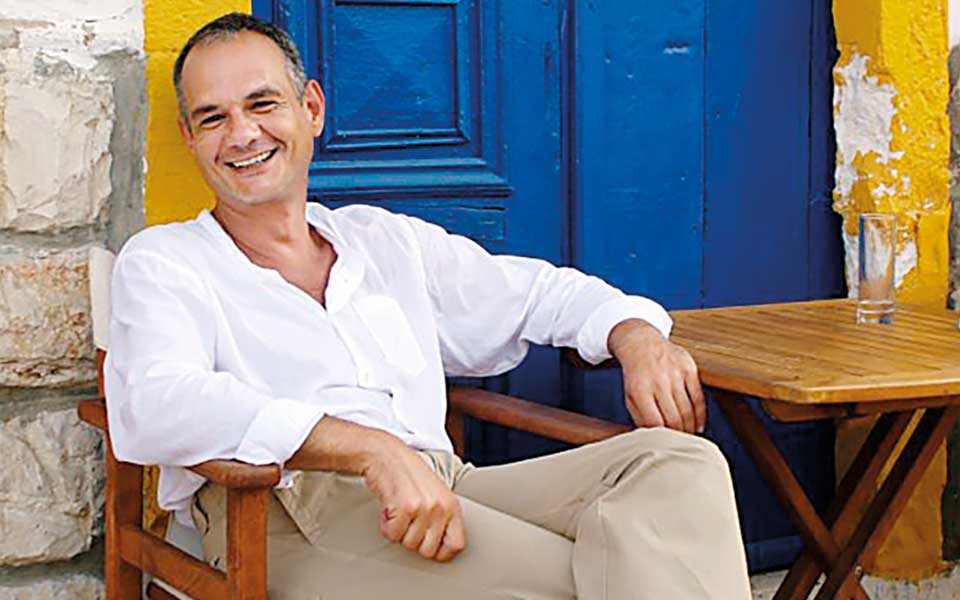
Nikos Trivoulidis
© Personal archive
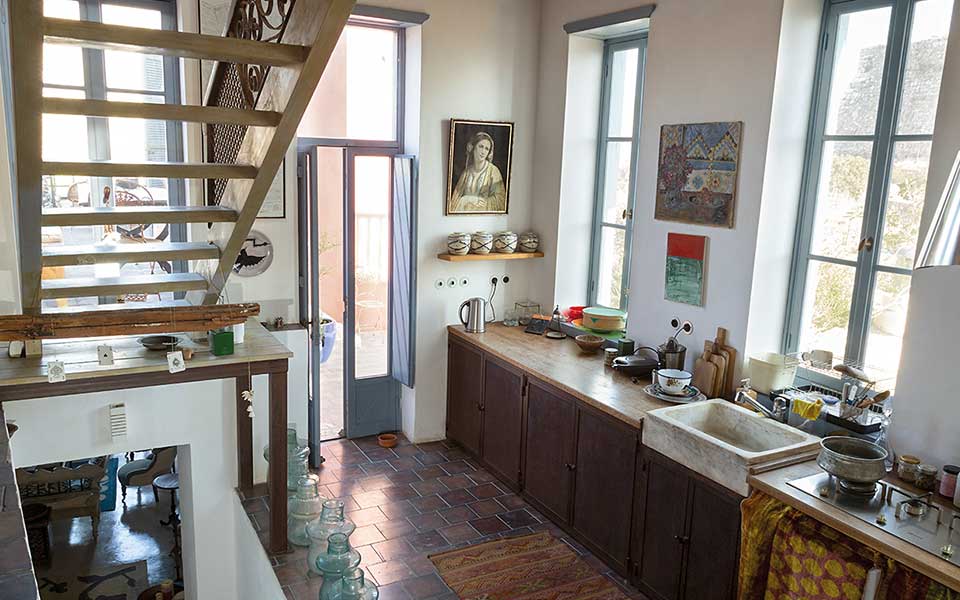
© Nikos Pilos
At the beautiful home of the Frenchman Luc Lejeune and his Vietnamese husband Vu Dinh Hung, chef at the Athenian restaurant Madame Phu Man Chu, evenings include everything from an introduction to Vietnamese cuisine to the occasional Shaolin choreography. Under Dina’s bougainvillea the conversations never end, spinning through the summer air like the blades of a fan. Once a year, Stefano hosts a performance that’s been in preparation all year long in Italy, and travels to the island for this single event.
Every so often Andreas and Lena host a dinner party that feels like a truly Greek embrace on their garden terrace near the castle, and each time, at some point, the breeze seems to die down and everything stands still, including the lights at the harbor in the distance. The gardens of Despina and Brian (who likes to be called Vyronas) or of the Australian Collin (who likes to be called Kostas) host guest chef appearances by Simone and Evana. In the yard shared by Davide Latilla (son of Carla Boni and Gino Latilla, bygone stars of the Italian singing world) and Angela Piergallini from Padua (a skilled oud player), Massimo and Angostina are careful not to miss a single step of the hasapiko they learned at a dance school.
And then there are all the stories I’ve heard! How could I possibly choose which to share first? Ludina Barzini telling us how her grandfather Luigi drove race cars at rallies in Mongolia with King Victor Emmanuel III. Dr Evangelos Hatzigiannakis talking about the fire on the “Empire Patrol,” which was bringing Kastellorizo refugees back from Gaza to the island. The artist Lynda Benglis relating stories about Andy Warhol’s Factory in 1960s New York. Sergio Mezzedimi describing his architect father Arturo’s relationship with Ethiopian Emperor Haile Selassie. Collin hesitantly sharing family Super 8 footage showing Stelios Kazantzidis and a young Vicky Moscholiou, who had once ended up at a barbecue in his parents’ backyard while touring in Australia!
There are, of course, the things that never change from summer to summer. The waters at the beach of Aghios Georgios, Plakes, Nifti and Frangolimnionas, diving into the water at the Blue Grotto, the mythical seal that no one has seen (yet everyone knows someone who has), the turtles swimming in the harbor, the full moon party celebrated in boats each August, with mojitos that theatre director Christos Lygas mixes in a tin bucket…
And if I had to choose one of these timeless beauties, it would be the sunset as seen from Paliokastro, from among those Cyclopean walls, ruined wells and churches. Kastellorizo, so distant from mainland Greece, between Rhodes and Cyprus, opposite the southernmost part of the Asia Minor peninsula, is positioned so that one can see the sun setting over Turkey, which we’re used to thinking of as the East. So you think you’re seeing the sun setting in the East. It’s as if image and place have melded. You don’t wonder what it’s doing there. You wonder at the fact that it was always there.
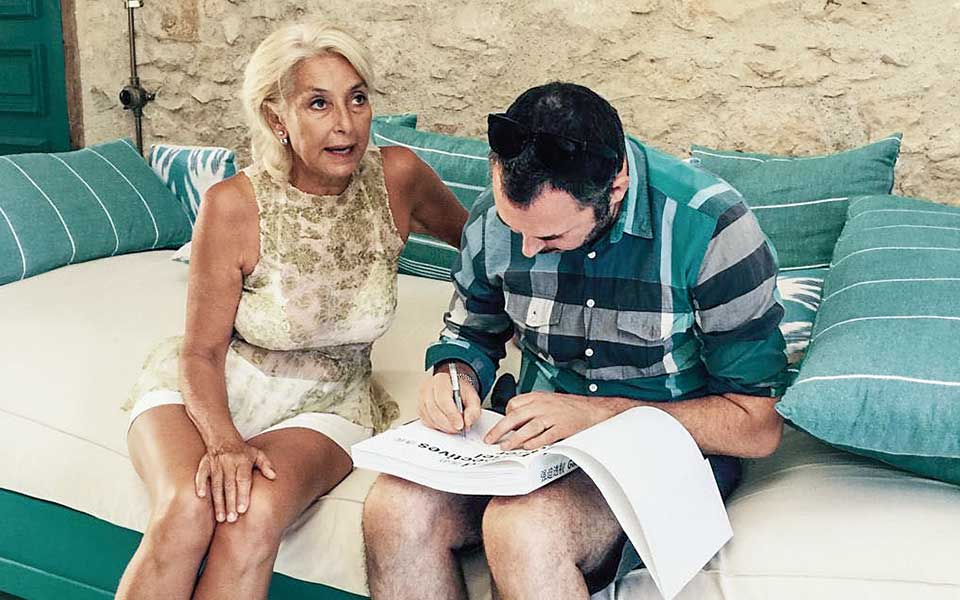
Nicoletta Fiorucci
© Personal archive
Collector, founder of The Fiorucci Art Trust
The first time I visited the island, I was 13 years old, and I’m now 63. The first images I saw were of an island destroyed. Having decided to build a house here, I also felt a responsibility to restore some of its monuments, such as the Turkish bath and the old fish market (mercato dei pesci), a building by the Italian architect Rodolfo Petracco, who designed public markets across the Dodecanese.
In all aspects, our interventions were conservative, with respect for the charm evoked by their original form. In the case of an old house in the harbor, our restoration was done with a more modern look, since only a plain shell was left, without traces of the past.
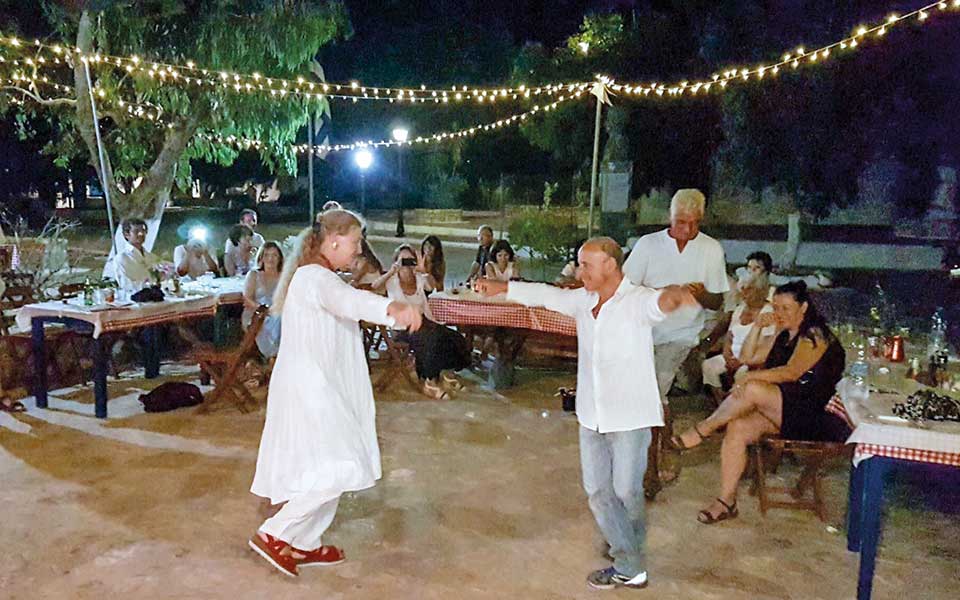
Mariangela Manzoni
© Personal archive

© Personal archive

© Personal archive
Architect
Life in Kastellorizo was quite difficult when I arrived in 1981. The population was very poor, and not even their basic needs were being met. Most important of all was the lack of fresh water, which was only available for two hours, three times a week. In the summer they sometimes brought in additional water and filled water tanks using pipes that had to be transported from one house to the other.
In those days, the locals didn’t have televisions yet, but they knew how to tell fascinating stories. When it was cold, they’d gather in those cafés that had stoves and tell each other stories for hours.
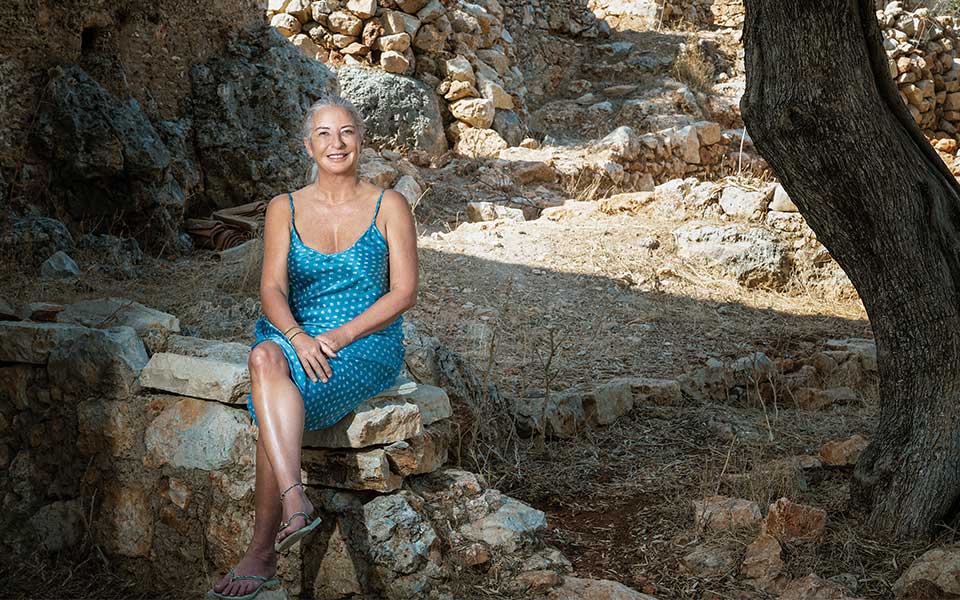
Silvia Fiorucci
© Nikos Pilos
Collector, founder of the NGO La Societa delle Api (The Bee Society)
As Italians, we have always felt welcome in Kastellorizo. Twenty-five years ago, when my then husband and I came and decided it was the perfect place to buy a house, you could still meet old residents who had learned Italian at school and enjoyed talking to us. Over the years, we bought a second house, and then a third one. The family grew, and my sons also loved Kastellorizo; I hope that my granddaughters will continue the tradition, since they have also grown up here, in a way.
The Casa dell’Ulivo project is my way of offering something to the island; a house in Pera Meria and its neighboring ruins, which I bought, will host artistic activities and, in the future, will be used for artist residencies as well.
The island must stay in step with the times, but memory must be preserved as well, and even more in a place like this, which has become a tourist attraction only in recent years. Its history and its inhabitants deserve to be appreciated by this and future generations.

© Kastellorizo friends

Ascania Baldasseroni
© Kastellorizo friends
Journalist
I’ve been coming to the island since 1978, and I’m one of the first Italians who bought a house here. I’ve never been worried about the island’s proximity to Turkey, and in fact I like the idea that I can go shopping in the flea markets over there. It is clear to me, after all: Kastellorizo is Europe. I do not mean that it isn’t Greek, but that it belongs to the European family.
I recently created the online magazine “afabulouslife” with the channel “afabulouslife.tv”. There is a section called “A Fabulous Island – Lettere dal Kastellorizo” there, and I upload videos from life on the island. These videos feature island cooking, gatherings with friends that turn into small celebrations with dancing and singing, and stories of people and things from the island.
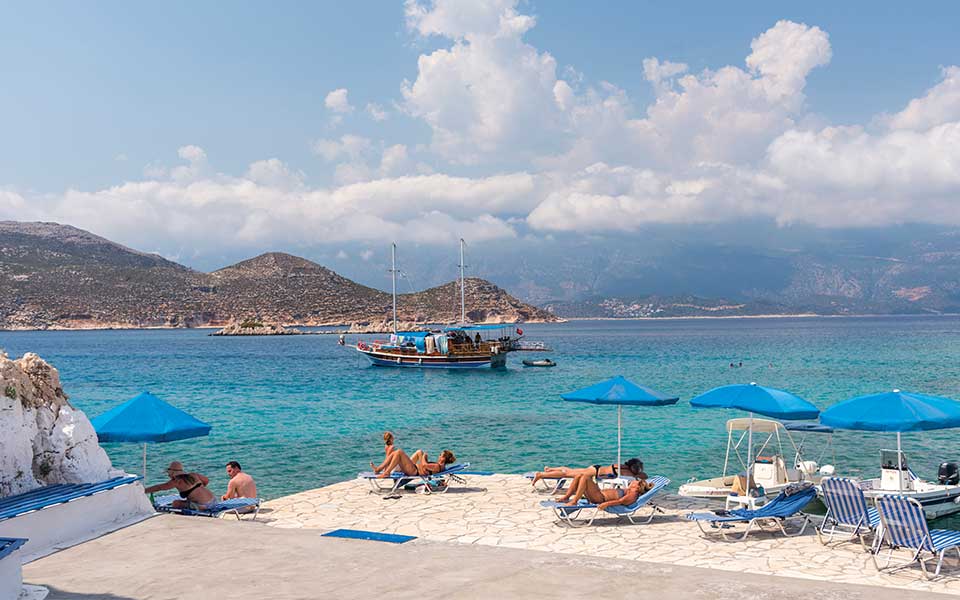
© Nikolas Leventakis
Honorary Consul of Greece in Djibouti
The greatest concern of all those who have invested in the island is that it not alter its basic physiognomy. Renovation projects are essential, but Kastellorizo does not need, for example, a modern waterfront. We must respect the traditional settlement and the past of the place, and studies must be undertaken by knowledgeable people who will be able to implement modernization projects without destroying the island’s aesthetics.
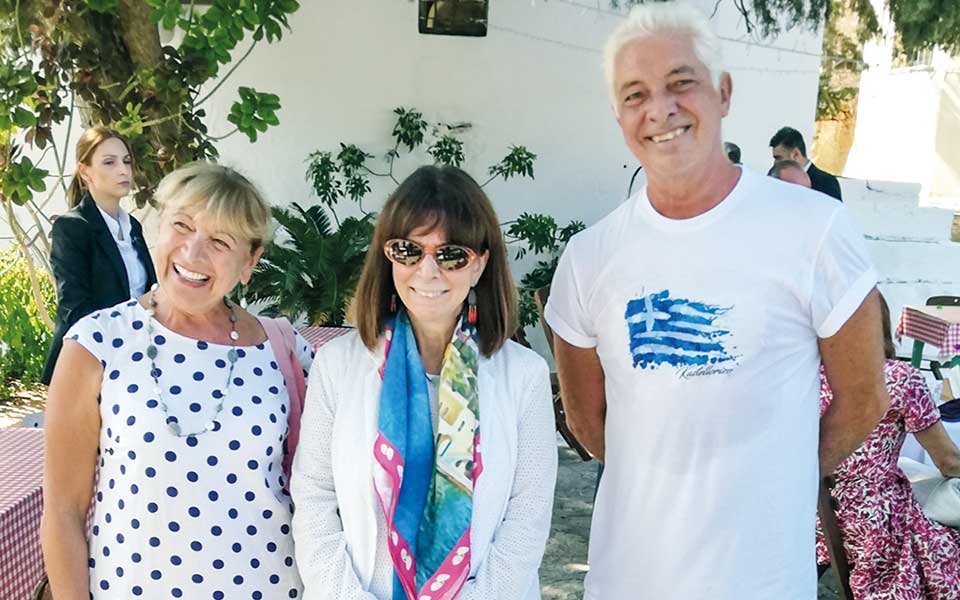
The President of the Hellenic Republic Katerina Aakellaropoulou with Massimo & Agostina Paradisi
© Personal achive
Retirees
The movie “Mediterraneo” was that which aroused our curiosity and made us want to see Kastellorizo up close, even though we knew it was a remote island that was really difficult to reach. Once we saw it, it was “love at first sight.” In 2006, our dream came true: all these years, we had wanted to spend much of our old age in this paradise of Greece.
One thing is missing from Kastellorizo, and that’s a large European flag next to the many Greek ones that are everywhere on the island, an imposing flag that would make it clear to anyone who causes or disturbs the calm in the region that in front of him/her is not a small, weak Greek island but the whole of Europe.
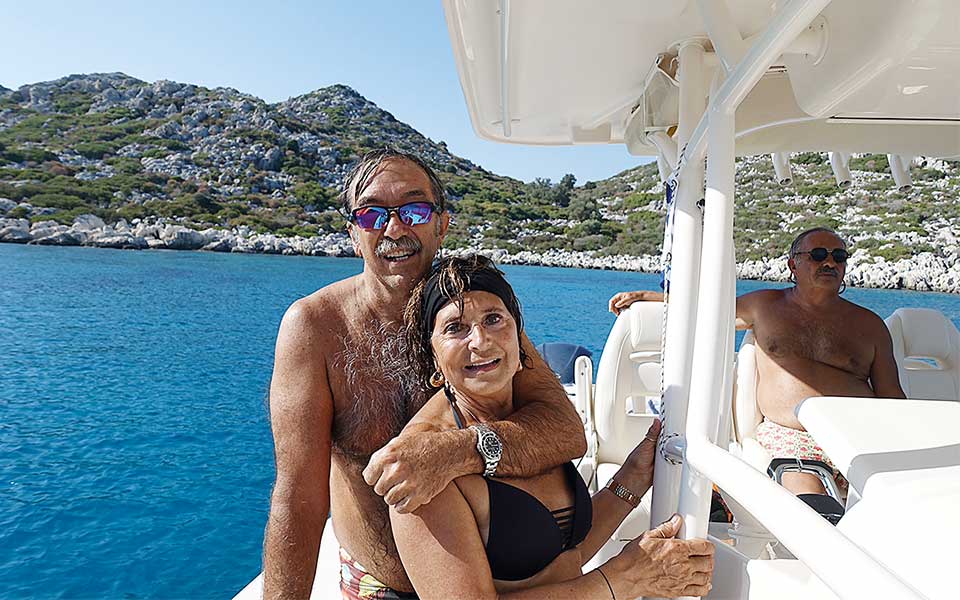
Stefano Ryan and Enrica Sutrini
© Personal archive
Entrepreneurs
I stopped in Kastellorizo in 1977, when the sail of our sailboat was damaged while my father and I were on vacation. The place was unspoilt – and the ruins so numerous, that you had the feeling that the war had just recently ended.
In 1982, I made the first attempts to find a property to buy but I ran into the complicated property ownership situation. I tried again in 1989, and finally succeeded in 1998. Since then, I have reminded myself what a big decision we made, choosing this island among so many other beautiful places that we had visited.
In Kastellorizo, I was attracted by its isolated beauty and its location between Greece and Turkey, Europe and Asia Minor, and I was fascinated by the rich history of the Levant, too. Although today Kastellorizo is different and, to a degree, perhaps a little “out of season,” as it were, it still gives you the feeling that you are on a private island.
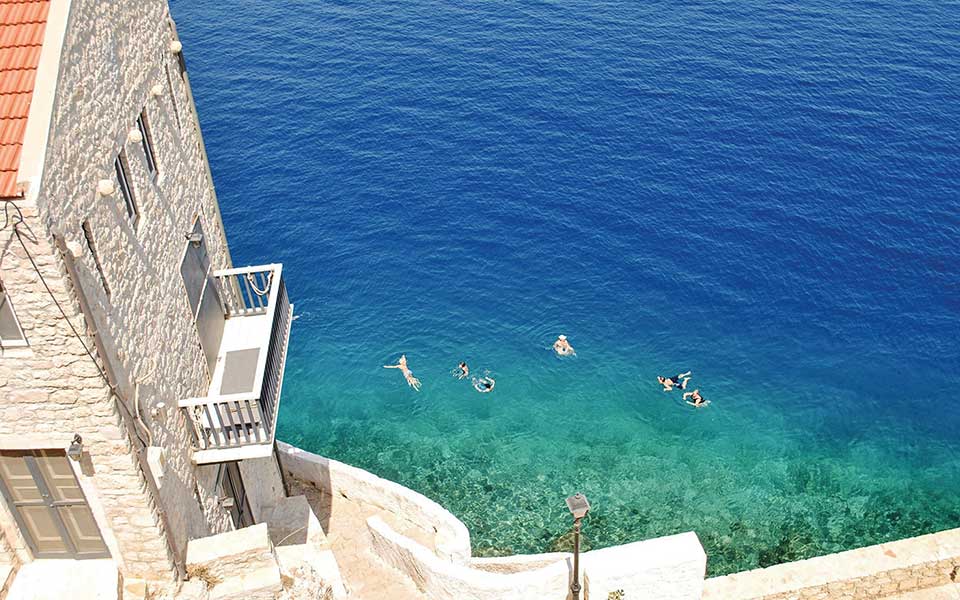
© Personal archive
London-based Artist/Designer
What I loved about Kastellorizo was its simplicity. I loved its dramatic landscape, the numerous walks (since there are hardly any cars), and its tranquility in the absence of nightlife. I enjoyed swimming there, and exploring its rocky countryside.
In fact, a walk on the island became the motive for the creation of two sculptures called “Horafia I” and “Horafia II,” which I presented at my first solo exhibition the year before last at the Taka Ishii Gallery in Hong Kong, as part of the Art Basel in Hong Kong show. The objects represent two palm tree trunks I saw outside a house on the island; their owners had turned them into stools.
While some historic buildings teeter on...
With its beautiful olive groves, emerald...
Unspoiled beaches, authentic flavors, and a...
Discover Greece’s islands in September with...